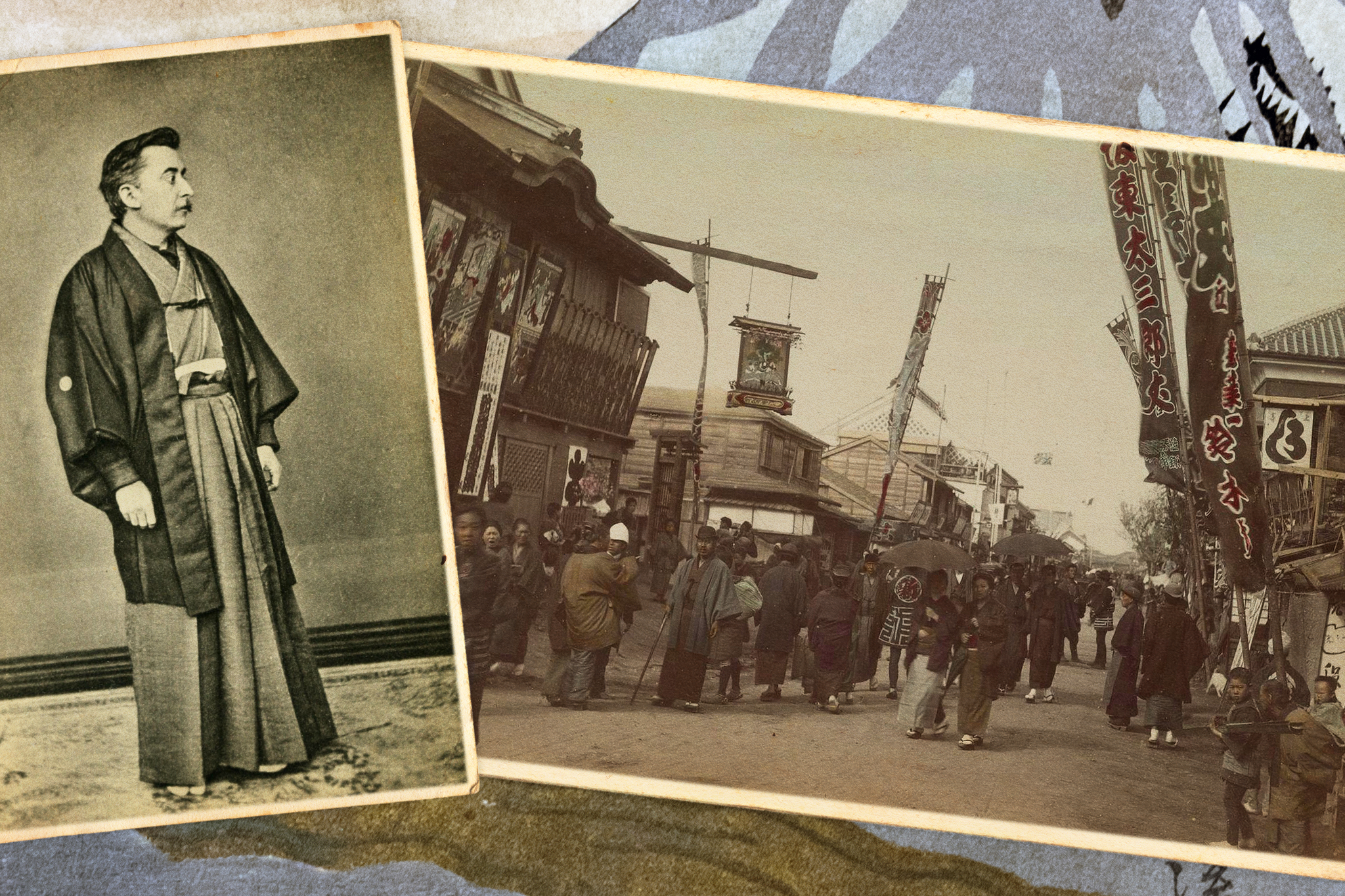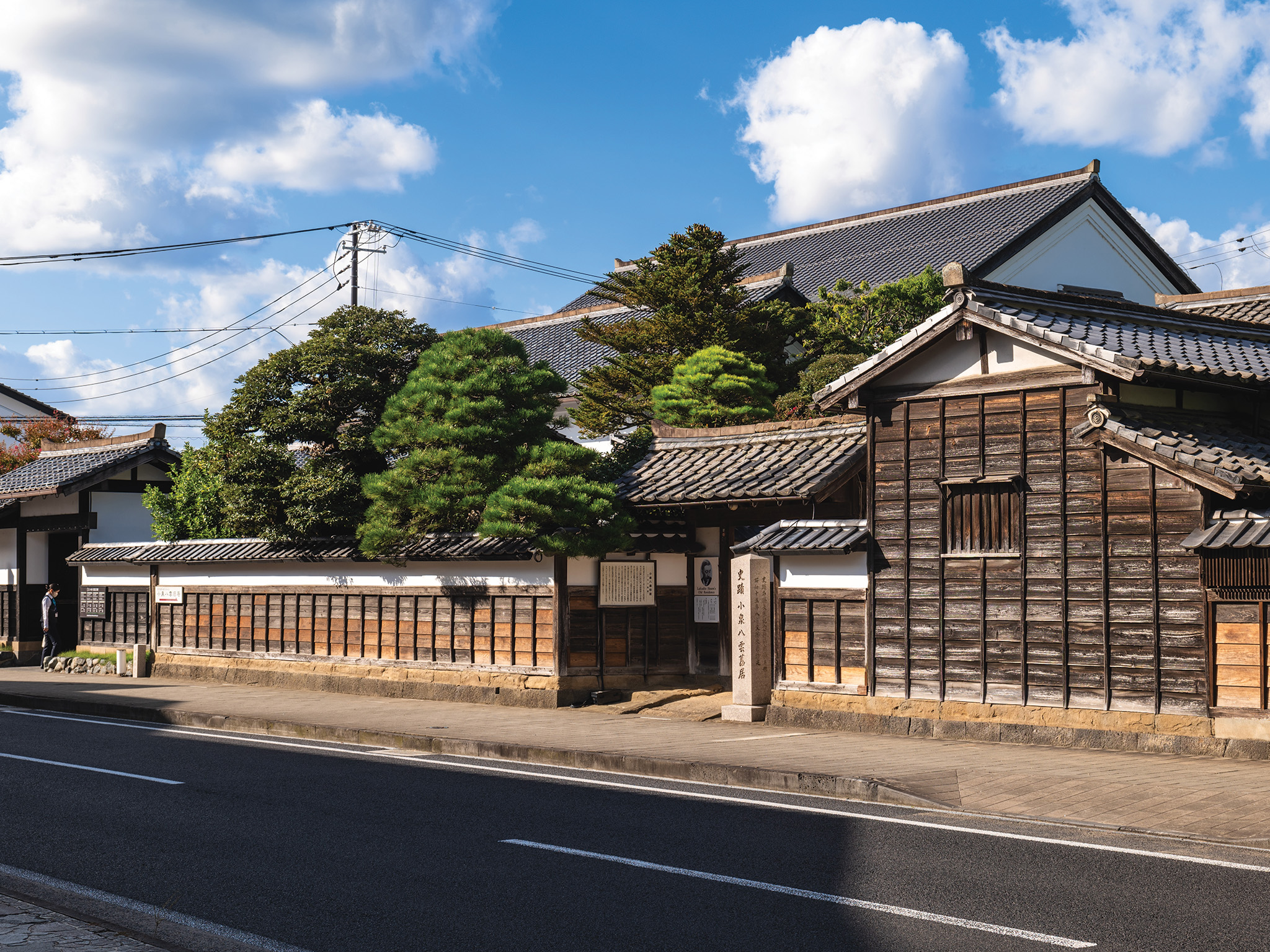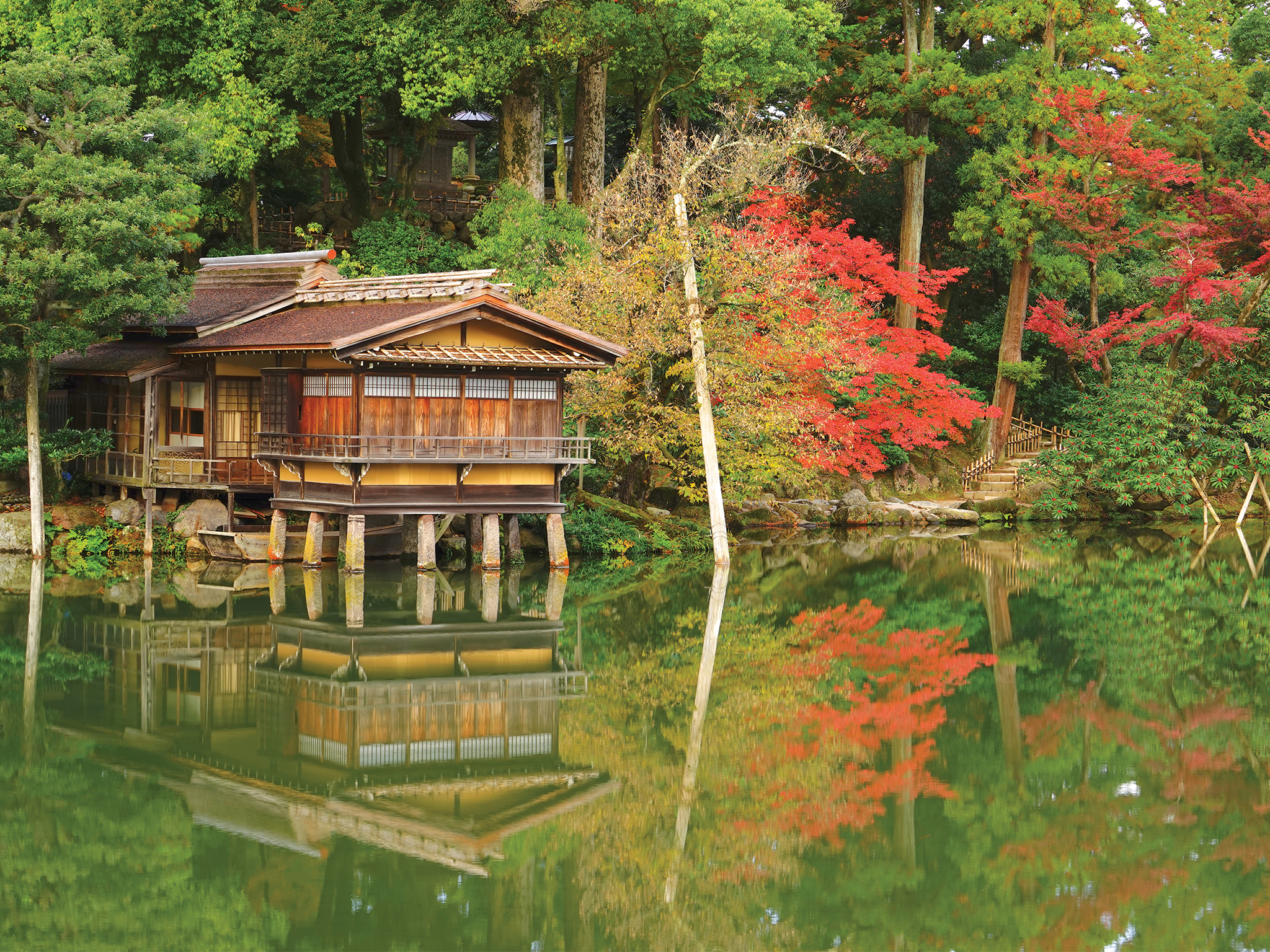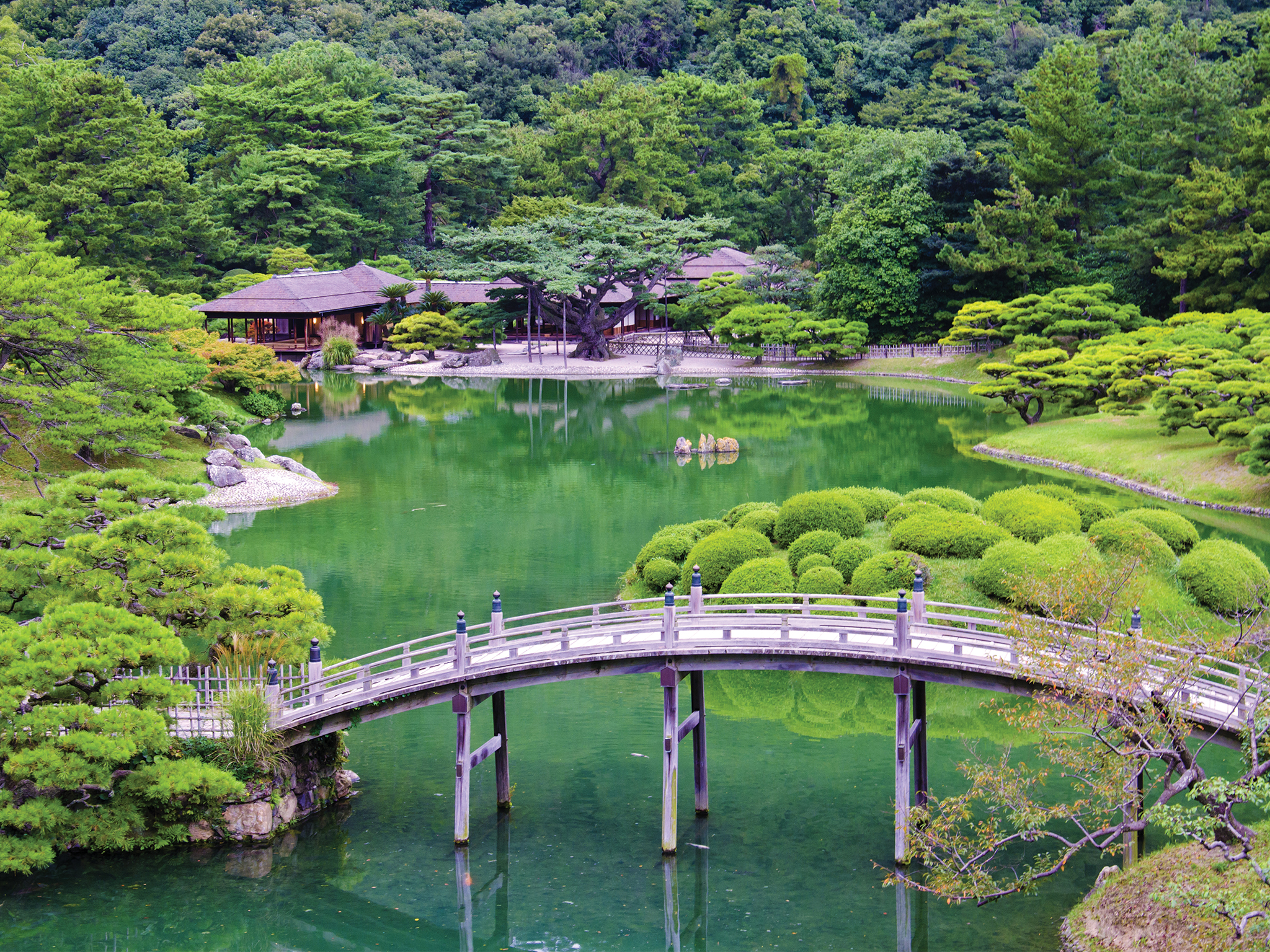Life in Japan taught Lafcadio Hearn many things, but one of his most enduring lessons was that Japanese art and design made Western sensibilities seem comparatively barbaric. Nowhere was he surer of this than when sitting on a veranda with his pipe in hand looking at a Japanese garden.

Lafcadio Hearn depicted on the left in traditional Japanese clothing
Lafcadio Hearn’s Reflection on Japanese Gardens
When Hearn moved to Matsue’s northern quarter in 1891, not far from the brooding gaze of Matsue Castle, he lamented the lack of a lake view and the densely wooded heights that cut off any prospect of seeing the horizon from his bedroom window. Instead, his house looked upon a series of gardens, which he soon conceded was fair compensation.
Hearn was an unapologetic aesthete, and the “daintiest manipulation” of Japanese gardening techniques always put him in a reverential mood. He discussed their virtues at great length in one of his most popular essays, In a Japanese Garden.
“I have come to understand the unspeakable loveliness of a solitary spray of blossoms arranged as only a Japanese expert knows how to arrange it… and therefore I cannot think now of what we Occidentals call a ‘bouquet’ as anything but a vulgar murdering of flowers, an outrage upon the colour-sense, a brutality, an abomination.
“Another fact of prime importance to remember is that, in order to comprehend the beauty of a Japanese garden, it is necessary to understand — or at least to learn to understand — the beauty of stones. Not of stones quarried by the hand of man, but of stones shaped by nature only. Until you can feel, and keenly feel, that stones have character, that stones have tones and values, the whole artistic meaning of a Japanese garden cannot be revealed to you.”

Lafcadio Hearn’s former residence located in Shimane
The Loveliest Japanese Garden
Hearn’s garden, which still exists at his former residence in Matsue, is just one of thousands across the country. Some are sprawling acreages on old feudal properties, like Kenrokuen in Kanazawa or Ritsurin in Takamatsu, others exist on a miniature scale, like bonsai tree displays or tiny tsubo-niwa gardens that fit comfortably inside a tokonoma (alcove).
It’s rare to see a Japanese garden that isn’t lovely, in its own way, but there’s one that can stake a claim to being the loveliest of them all. The garden at the Adachi Museum of Art in Shimane, a short drive from where Hearn once lived, has been voted the most beautiful in Japan for more than 20 years in a row by Sukiya Living, a US-based magazine also known as the Journal of Japanese Gardening.
The garden, which is technically a collection of five gardens, is an exercise in communication and impressionism. There is no overindulgence. Rather, it allows gently rolling mounds covered in snooker-table grass, raked white stones and slabs of mountain rock, and carefully arranged pine trees to instill a sense of meaning.

A Picture and a Poem
“No effort to create an impossible or purely ideal landscape is made in the Japanese garden,” wrote Hearn. “Its artistic purpose is to copy faithfully the attractions of a veritable landscape, and to convey the real impression that a real landscape communicates. It is, therefore, at once a picture and a poem; perhaps even more a poem than a picture.”
As I drove through the thickly wooded back roads of Shimane en route to the Adachi Museum of Art in 2020, I fought hard to temper my expectations. Japan has a habit of trumpeting any accolades awarded to its tourist attractions, no matter how tenuous they seem — the “top 100 castles,” the “shortest ferry route,” the “most important tangible folk cultural properties” — often setting the intrepid traveler up for disappointment. But perhaps it’s telling that a lot of Adachi’s accolades have come from abroad.
When I arrived at the museum, I decided to leave the gardens until the end, pottering around the exhibition spaces instead. Two themes quickly emerged: a celebration of Japanese nature and mysticism through art, and a translator who’d been given too much creative control.
Works by the ceramicist Kitaoji Rosanjin — bamboo vases and fruit-shaped pots — “effuse a dense unique personality across a wide range of areas.” Hanging scroll paintings show a lion “full of panache” and “frogs frisking.” The magnum opus of Yokoyama Taikan, a folding screen depicting autumn leaves, is described as “particularly splendorous,” and his painting of a mist-shrouded dragon has “serious verve.”
The descriptions might be excessively purple, but they are there to make a point. The garden — “splendorous” as it may be — is framed to look like one of Taikan’s paintings. One must view it through apertures in the museum, as though entering it would be tantamount to defiling an artist’s work.
Shakkei: Enhancing a Man-Made Landscape
The garden represents, therefore, a kind of non-space. It exists in three dimensions, but functions more like a slowly moving portrait, or a “living canvas,” in the words of Adachi Zenko, the museum’s founder. The imagery shifts when a breeze wafts through the valley, carps circle each other in a pond, or a mist settles amid the creases of the Chugoku Mountains.
Of course, there is poetry in it too, dictating the emotional response of the viewer by mirroring the style and rhythm of the natural world. In fact, it is impossible to tell where the garden ends, and the surroundings begin, as though they are both seamless extensions of the other. Shakkei, the Japanese might call it — the thoughtful use of scenery to enhance a man-made landscape.
Adachi’s design is, I think, proof that great artists steal. The garden is not a weak homage; it has appropriated the raw materials and essence of its environment, and turned them into something inspired, something better, something new.
Hearn never lived to see the Adachi Garden as it was constructed several decades after his death. But perhaps he had a point. If you tried to spruce it up with vibrant floral bouquets, an excessive color scheme, or the perfection of symmetrical design, it would indeed be an abomination.
Related Posts
- Tokyo’s Best Secret Gardens
- 8 of the Most Beautiful Parks & Gardens in Tokyo
- What’s in a Japanese Garden?
Updated On February 1, 2024








